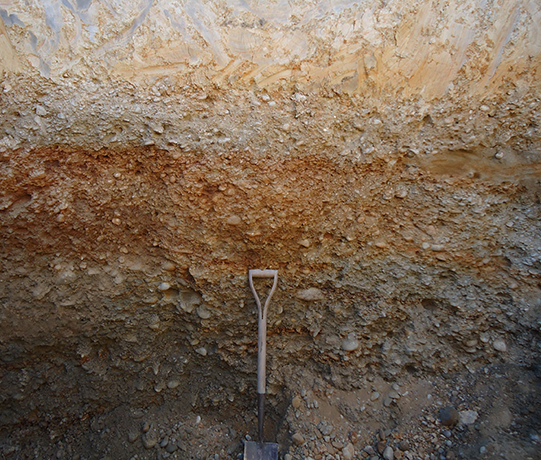Origin of the Fundamental Soil Layers
The NZ Fundamental Soil Layer originates from an expert derived join of attributes measured in the National Soils Database (NSD) and the polygon boundaries of the New Zealand Land Resource Inventory (NZLRI).

The soil fundamental data layers (FDLs) contain spatial information for 16 key attributes. These soil attributes were selected through a consultation process with stakeholders, and fall broadly into three groups: soil fertility/toxicity, soil physical properties (particularly those related to soil moisture), and topography/climate.
The 16 attributes described are:
- slope
- potential rooting depth
- topsoil gravel content
- proportion of rock outcrop
- pH
- salinity
- cation exchange capacity
- total carbon
- phosphorus retention
- flood interval
- soil temperature
- total profile available water
- profile readily available water drainage
- macropores (shallow and deep)
Regional soil databases were the key to generating FDLs. New Zealand was subdivided into several geographic regions and soil scientists were allocated a region for which they developed a ‘regional legend’, i.e. database. Regional data were correlated using the New Zealand Soil Classification (NZSC), referenced to the National Soils Database (NSD) and other relevant data sources, and then linked to the soil polygons in the New Zealand Land Resource Inventory (NZLRI).
While every effort has been made to supply a nationally consistent data set, there may be variations in classification, attribute values, and scale and precision of mapping depending on time and region of soil data collection.
Note: FSL predates and is being replaced by S-map, which is considered better quality and more reliable data. However, there is not yet national coverage for S-map so some people may still need to refer to the FSL.
New Zealand Land Resource Inventory
The NZLRI was an attempt to map at the national scale five physical factors that drive land use capability. It is a powerful tool for managing land, planning resource use, or environmental research.
You can obtain NZLRI data from Landcare Research's LRIS Portal (search term: NZLRI)
Maps based on NZLRI data are viewable in the Our Environment website.
The main features are the NZLRI are:
- An inventory of five physical factors controlling land use—rock, soil, slope, erosion and vegetation.
- Land Use Capability (LUC) assessments. These are shown as map units or land ‘parcels’ that are essentially uniform with respect to physical characteristics (i.e., the factors described in 1.).
- Derived Fundamental Data Layers (FDLs) which contain data for 16 key soil attributes for all New Zealand soils.
- Pastoral and forestry production parameters, plus administrative and natural boundaries.
These allow comparative land use studies within a wide range of national or regional areas.
The creation of the NZLRI started with stereoscopic analysis of aerial photographs and satellite images. Land considered to have uniform rock, soil and slope characteristics is delineated according to surface geology, geomorphology and soils. Erosion and vegetation categories are used to further subdivide units. Extensive field work and consultation with land managers follows to check all delineated units. The final map unit boundaries, inventory codes and LUC assessments were compiled onto a base map. Adjacent units differ in one or more inventory factors. Completed, checked maps were published as NZLRI worksheets.
The NZLRI spatial database contains similar information to that in the NZLRI worksheets. There are about 100,000 polygons (map units) within the NZLRI, each of which describes a parcel of land in terms of five characteristics or attributes (rock, soil, slope, erosion, vegetation). Soil information is adapted from publicly available soil surveys produced by Landcare Research(and its predecessor organisations.
How can NZLRI be used
Inventory, land-use capability or legend information can be used in planning at national, regional, district and catchment levels. On a national level, for example, Electricorp via a consortium of consultants, used the NZLRI to plan a corridor for routeing new transmission lines. NZLRI was used because it was the only complete computerised land database for New Zealand. Planning the corridor required accessing NZLRI information on potential erosion, rock type, LUC class, slope and vegetation cover for 10 million hectares, from Otago to Auckland. Thousands of work hours were saved using NZLRI.
At a regional level, an innovative study of Taranaki sustainable land used for land-use monitoring purposes was developed from the NZLRI and LUC information. Slope and aspect were identified as key factors determining sustainability. Many district councils have incorporated NZLRI data into their district scheme. Remapping at more detailed scale of 1:50,000 is making the material even more useful to local authorities.